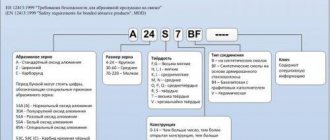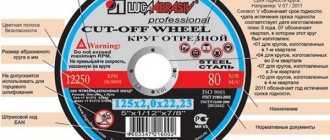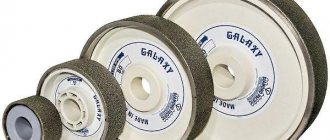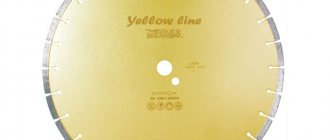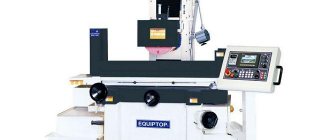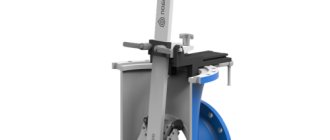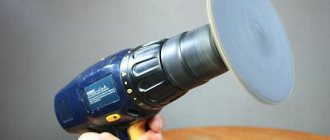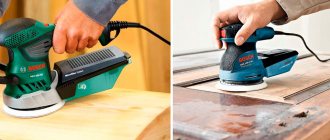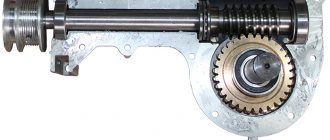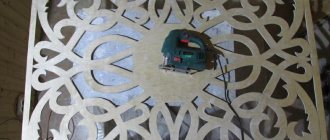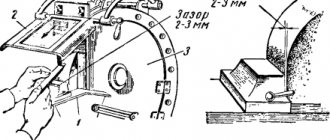Scope of application
Grinding wheels are used for preliminary and finishing processing of products made of ferrous and non-ferrous metals, plastic, wood and other materials. The area of application of the wheel is determined by its grain size, diameter and surface shape. Using a circle, it is possible to process flat and shaped surfaces, ends, threads, holes, etc.
The main area of application of grinding wheels is mechanical engineering and machine tool construction. Depending on the geometry, they can be used as equipment for sharpening machines, hand-held electric or pneumatic tools. They can also be used for manual operations. A wide selection of tools allows you to carry out a wide range of operations - from roughing and rough finishing to finishing grinding and polishing.
Best Bolt-On Grinding Wheels
Such models are distinguished by reliable fixation and reinforced construction. They are highly durable, can be used under intense loads and do not wear out for a long time.
3M 57018
5
★★★★★
editorial assessment
97%
buyers recommend this product
These discs have increased flexibility and elasticity. The unique three-dimensional design of the abrasive eliminates the possibility of clogging and surface deformation even with intense rotation of the wheel.
The diameter of the equipment is 100 millimeters, thickness - 13. The disk is not subject to rapid heating, which is especially good during prolonged operation. The Roloc mount makes it easy to install and remove discs for replacement.
Advantages:
- simple fastening;
- wear resistance;
- fast cooling;
- elastic material;
- long service life.
Flaws:
- high price.
3M 57018 wheels are designed for cleaning parts from rust, old paint, sealants, etc. Convenient for use in hard-to-reach places or processing textured surfaces.
Stayer 36228-150-6.0
4.9
★★★★★
editorial assessment
95%
buyers recommend this product
Stayer circles are manufactured using multilayer reinforcement technology using fiberglass mesh. This ensures high strength, resistance to deformation and fracture, as well as a long service life of the disks.
The outer diameter is 150 millimeters, thickness is 1.6 mm. The main material used to make abrasives is aluminum oxide. The discs can be used at a maximum rotation speed of up to 10,200 rpm.
Advantages:
- durable, thanks to reinforced construction;
- large thickness;
- high-quality surface treatment.
Flaws:
- complex installation.
Stayer discs are suitable for cleaning welds, chamfering and deburring steel parts.
BISON 36204-150-6.0 z02
4.9
★★★★★
editorial assessment
94%
buyers recommend this product
In these models, multilayer reinforcement of the bakelite bond is made using polyamide mesh. It guarantees high strength of the wheels, resistance to intensive use and long service life.
Disc diameter - 150 mm. The thickness of 6 millimeters provides the rigidity necessary for difficult conditions of use. The main abrasive material is aluminum oxide.
Advantages:
- high strength and durability;
- reinforced design;
- reliable fixation;
- large diameter.
Flaws:
- rough processing only.
Professional ZUBR discs are recommended for primary grinding of metal at a maximum tool rotation speed of 10,200 rpm.
JTC Auto Tools 3731
4.8
★★★★★
editorial assessment
90%
buyers recommend this product
Each JTC wheel features a one-piece, high-strength construction that ensures long service life and stable rotation during intensive use of the grinder.
The dimensions of the circle are 85x15 millimeters, weight 157 grams. Small sizes make it easier to process narrow parts and textured surfaces. Fastening is carried out using one screw.
Advantages:
- high strength;
- simple fastening;
- light weight and compactness.
Flaws:
- It will take a long time to sand.
JTC Auto Tools wheels are designed for precise grinding and processing of small parts made of various materials.
READ ALSO
12 best engravers
Grit size of grinding wheels
Grit size is one of the main parameters for choosing a grinding wheel for certain operations. It is determined by the grain size of the fraction divided into fractions in accordance with the group of grinding material and is indicated by the corresponding numerical value.
There are three main groups - grinding grain, grinding powders and micro-grinding powders. In the first two groups, grain size is determined by the smallest grain fraction in hundredths of a millimeter. So, for example, 40 means a fraction size of 400 microns or 0.4 mm. In the third group, micro-grinding powders, the numerical value determines the largest grain size in the fraction in microns and has the additional designation M. For example, M20 is a circle with the largest grain size in the fraction of 20 microns.
The table below shows data on the grain size of the groups in accordance with GOST 3647-80 and the international standard ISO 8486.
The best velcro sanding wheels
Such models are distinguished by the presence of special fasteners that ensure quick installation and removal. As a rule, they are supplied as a set of several circles and have a low cost.
Makita P-43533
4.9
★★★★★
editorial assessment
95%
buyers recommend this product
High-quality Velcro ensures reliable fastening of the discs included in the set. There are 10 of them here, the diameter is 125 millimeters. A solid base and tight fit of the abrasive guarantee long-term preservation of the properties of the discs during intensive use. And numerous holes quickly remove sanding dust from the working area, which makes for comfortable use.
Advantages:
- reliable fixation;
- rapid dust removal;
- solid foundation and long resource.
Flaws:
- large grains.
Makita discs can be used when processing painted surfaces, wood, and metal. A reliable choice for professional use.
Hammer 214-012
4.9
★★★★★
editorial assessment
94%
buyers recommend this product
The models included in the set have a durable fabric base. It is flexible, wear-resistant, not subject to stretching and is also treated with water-repellent impregnation.
Disc grit: P400, diameter 125 millimeters. An artificial resin is used as a binder, which ensures effective heat dissipation. The abrasive is made of aluminum oxide, the granules of which self-sharpen during the grinding process and are not afraid of rapid destruction.
Advantages:
- waterproof base;
- rapid cooling of grains;
- high strength;
- wear resistance;
- long resource.
Flaws:
- rough processing.
Hammer 214-012 discs will be useful for owners of eccentric sanders. Professional equipment is designed for processing wood, metal and plastic.
Vira 558017
4.8
★★★★★
editorial assessment
89%
buyers recommend this product
The optimal size of Vira wheels (125 mm) allows you to process both narrow areas and large surfaces with equal efficiency.
Thanks to the use of electrocorundum, the discs can be used for grinding metals and alloys. The abrasive is fixed on a pile base. Large granules prevent the wheels from quickly clogging, which extends their service life. The number of discs in the set is 5.
Advantages:
- easy installation;
- long service life;
- optimal sizes;
- versatility;
- low price.
Flaws:
- low density.
Vira 558017 are recommended for use with angle grinders. They can work with metal, wood, plastic and other materials.
Wolverine 435150
4.7
★★★★★
editorial assessment
87%
buyers recommend this product
Semi-open filling and high-quality components ensure high performance when using Wolverine wheels, as well as ease of surface processing. Parts and blanks can be made from various materials, including metal and wood.
The diameter of the discs is 125 millimeters, the grit size is P150. The package includes five circles with durable pads made of special fabric. Velcro type Velcro is used for quick fixation.
Advantages:
- easy installation;
- increased resource;
- versatility;
- low cost.
Flaws:
- heat up quickly.
Wolverine wheels are suitable for eccentric grinders used in everyday life.
READ ALSO
10 best saw blades
Profile
The profile of a wheel determines whether it can be used for certain operations. We list the most commonly used types of profiles:
- Flat with a straight profile - internal or centerless grinding, torus processing and other operations.
- Flat double-sided with a conical profile – processing of gears and simple threads.
- Flat with undercut – cylindrical grinding, end trimming.
- Cylindrical and conical wheels – sharpening of tools and other operations.
- Disc wheels – sharpening of tools with multiple cutting blades.
Types and technological application of grinding wheels
Abrasive grinding by rotation is carried out using:
- circles;
- heads;
- cutters (cones);
- segments.
The quality after grinding depends on the class of the grinding wheel. There are three of them: A, B and AA. Class B grinding wheels have the lowest accuracy, and AA wheels have the highest (precision grinding machines are usually equipped with them). The accuracy of a grinding wheel is determined by its geometry, the composition of the abrasive material on the wheel, and the grain size.
In the practice of grinding or straightening on machines and hand-held machines, one-time fastening of the composition to the base is often used. In fact, it is sanding paper with a Velcro backing. Such “circles” with Velcro are used mainly in everyday life, for hand-held machines, and with little metal removal, in particular, when straightening.
Sanding cloth wheels for profile sanding
On the contrary, when removing a significant amount of metal, home craftsmen often use cutters - attachments on a regular electric drill that look like a milling cutter. The roller, rotating at high speed, performs rough grinding of surfaces after drilling or milling work. The cutters are compact and have a small working surface diameter. Roller cutters, however, cannot provide high torque.
Standard designations
Marking is determined by GOST 2424, and includes the following varieties:
- for operations of roughing (roughing) grinding of metal, internal or external, dressing mainly by the periphery - wheels with a straight profile (PP);
- for processing threads and other periodic profiles on metal - double-sided conical (2p) or disc-shaped (t);
- for sharpening and editing friction cut-off saws – conical single-sided (3p);
- for centerless grinding of metal - wheels with one- or two-sided recesses (PV);
- for face grinding with a flat surface - ring (k).
Explanation of the abrasive grinding wheel
A separate category is sharpening, straightening, and grinding of friction surfaces of metalworking machines. Such circles are called cup circles, and are marked CC or CHK.
Explanation of the grinding wheel label
The above nomenclature refers to solid wheels that perform an operation with their entire working perimeter (dressing, rough grinding). When using stacked grinding wheels, special segments are used, which are installed in the corresponding seats of the wheel body on a machine or machine. They are produced in accordance with the technical requirements of GOST 2464. Stacked segments can be used to process hard-to-reach surfaces (for example, rail cavities, narrow grooves in metal or stone). Grinding segments are more economical when dressing and make routine maintenance of the machine easier.
Grinding wheel marking scheme
Marking
The main parameters of the circle can be determined by its symbol, which is indicated in the product labeling. The symbol corresponds to GOST R 52781 and indicates:
- circle type;
- material;
- grain;
- geometric parameters (outer and inner diameters, height);
- type of ligament;
- structure and degree of hardness;
- the highest permissible processing speed.
The exception is wheels with individual markings, which have wheels from foreign manufacturers. When purchasing this product, you must study the information in the catalogs and on the packaging.
Selection rules
The main factor in choosing a grinding wheel is the parameters of the material being processed and the scope of application (machine tool, hand tool). Another important factor is the quality of processing, determined by the grain size of the wheel. The larger the grain size, the higher the surface layer removal rate, but the lower the surface quality. For this reason, fine-grit wheels are used for fine grinding.
The table below provides data on the choice of grit depending on the grinding operation.
It is desirable that the circle matches the material for which it is intended. This is indicated in the manufacturer's recommendations, in particular in the form of an image on the label. Pay attention to the permissible rotation speed, which is an important condition for safe work.
Vulcanite and bakelite grinding wheels
Diamond coating is quite expensive, so it is applied in a very thin layer to a metal base. Abrasive wheels with less strength are formed in a different way. Often, for this purpose, a binder ceramic composition is used, where the main components are materials of inorganic origin (quartz, clay, etc.). Highly ground, these binders are added to the selected abrasive when forming the wheel, providing the finished product with increased rigidity, but also corresponding brittleness.
Bakelite circles
Bakelite nozzles are in great demand on the market. They owe their name to the main filler – bakelite (artificial resin). This binding component gives the circle elasticity and a kind of elasticity, but at the same time wear resistance is reduced as a result of weaker fixation of the grains (compared to a rigid ceramic base).
It is important not to forget that a rigid base of high hardness can lead to overheating of the metal being ground and, accordingly, burnout of the surface of the processed element. Bakelite nozzles do not have this drawback. They are much softer, so they heat the metal very little and are capable of self-sharpening when processing a part.
Wheels on vulcanite bond
The grinding wheel with vulcanite binder is even softer. Here the main abrasive element is synthetic heat-treated rubber. In other words, vulcanization is used in the production of such grinding attachments, which is reflected in their name. Vulcanite wheels have a higher cost compared to ceramic abrasives. However, despite the increased elasticity, their wear resistance is beyond praise.
